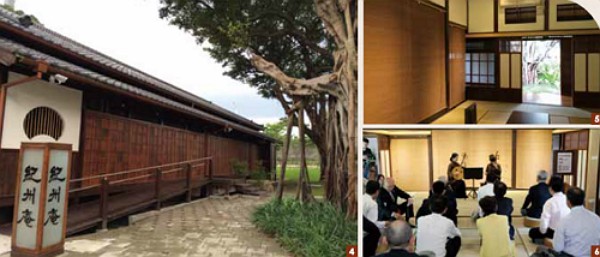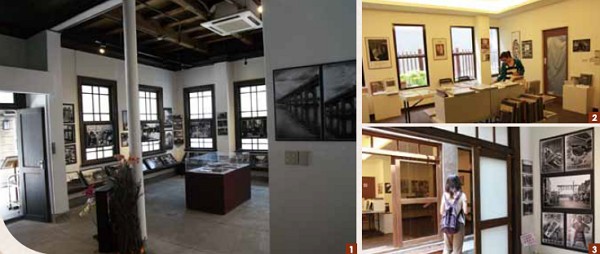New Bastions of the Arts--Historic Structures Returned to Their Former Elegance
This year is the 130th anniversary of this city's founding. You'll find a comprehensive array of architectural styles spread throughout the neighborhoods of this sprawling metropolis, and each heritage structure has its own special tale to contribute to the story of Taipei. Each also contributes to the city's cultural nourishment, and is a window into the special beauty of its history. Two prime examples are the Futai Street Mansion (撫臺街洋樓) and Kishu An (紀州庵), both official city heritage sites, where the photography and literary arts are combined to reproduce the elegance of the past and showcase the beauty of the old walled city. Futai Street Mansion – A New Base for Photographic Art Futai Street Mansion was built in 1910 for use as a store. Wood and stone are prominent structural features, and there are also numerous unique architectural motifs and symbols, such as the ground-level four-pillared, three-section arcade, a steeply slanted roof on the façade side, and dormer windows that let both natural light and fresh air flow in. The building has continued to stand tall and proud through the later years of the Japanese era and the modern Republic of China era, and was declared a city heritage site in 1997. Today the mansion's primary role is to serve as “Taipei Photography Center” (臺北攝影中心), staging photography-related exhibitions, activities, and talks. Photography art is used to present Taipei’s culture, and the photos act as a bridge between the past and present. The facility's first exhibit in this role, “A Photo Exhibition of Taipei City in the 1940s” (臺北城風情特展), is focused on Japanese-era Taiwanese photographer Li Huozeng (李火增). Photos he took between 1938 and 1942 vividly depict local life in that era. Curator Jian Yongbin (簡永彬) has filled the exhibit space with photography books, magazines, and exhibition posters collected by the photography planning and research studio Sunnygate Phototimes (夏門攝影企劃研究室). Another interesting space at the mansion is the rooftop terrace at the rear, where architecture professor He Junxian (何俊賢) has created a small urban farm as a model promoting “urban granary” ecology and green concepts. Kishu An – Creating a “Forest of Literature” Built in 1917, Kishu An was a typical Japanesestyle dormitory residence, comprising a main building, secondary building, and annex. Unfortunately, the main building and annex suffered two separate fires a decade or so ago, leaving only the long secondary structure intact. This facility was originally used for upscale banquets, and one can imagine the grandiosity. To give people a clearer glimpse of the past, the Department of Cultural Affairs, Taipei City Government (臺北市政府文化局), restored this heritage structure, and on May 25th this year held a grand “Municipal Heritage Site – Kishu An” reopening ceremony. Integrated with the Kishu An Forest of Literature (紀州庵文學森林), a new building constructed in 2011, the duo present a brand-new look at history. Located in the city's south, this was once a favorite meeting place for the literati as well as for publishing and books tore profes s ional s . For thi s reason a literary theme has been chosen for the site, and the architecture has been allowed to tell its own story. In combination with the Kishu An Forest of Literature, an attractive venue of static exhibitions and lecture events has been created. There are also cross-culture activities such as stage theater, puppet theater, and traditional nanguan (南管) musical performances, as well as teaarts talks, new book launches, and children's story-house presentations. Interweaving traditional aesthetics and literature, the old and new architectural facilities at this attraction have been transformed into a multi-diverse bastion of the arts. Walk through Taipei's old walled city area and surroundings and you’ll feel that you can “read” a little bit more of the city’s story with each venerable structure you encounter. The addition of a cultural-arts focus brings even more dynamism to selected revitalized buildings, highlighting their unique heritage character and helping us delve deeper into Taipei’s history, better grasping a historical tale told nowhere else.
Information Futai Street Mansion 撫臺街洋樓 Add: 26, Yanping S. Rd. (延平南路26號)
Tel: (02)2314-8080
Hours: Mon~Sat 10:00~18:00
Website: ww.facebook.com/futai1910 (Chinese) Kishu An Forest of Literature 紀州庵文學森林
Add: 107, Tongan St. (同安街107號) Tel: (02)2368-7577
Hours: Tue~Sun 10:00~17:00
Website: www.kishuan.org.tw (Chinese) 

![Taiwan.gov.tw [ open a new window]](/images/egov.png)
